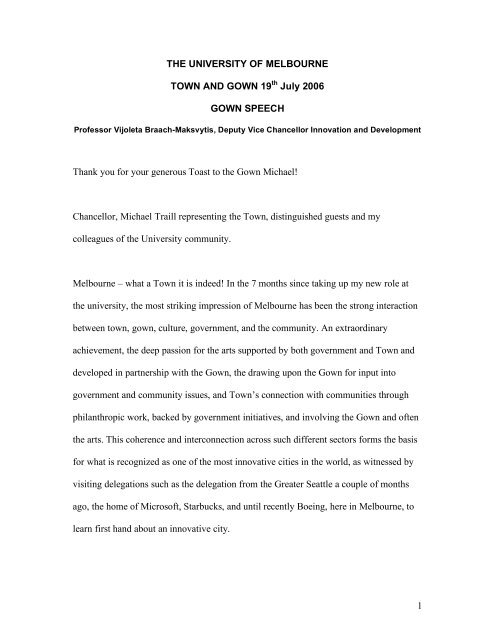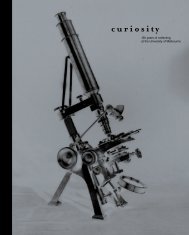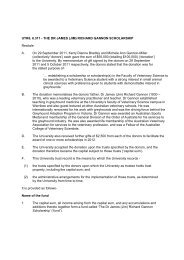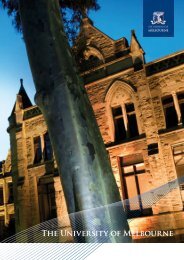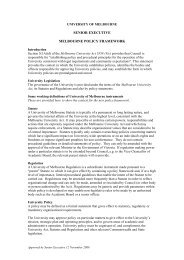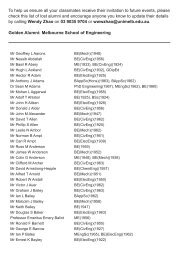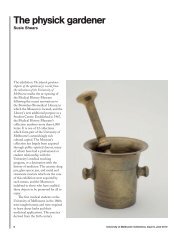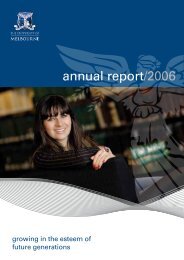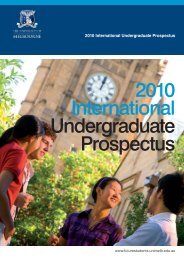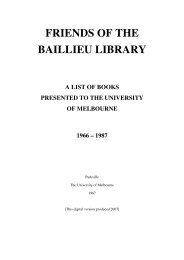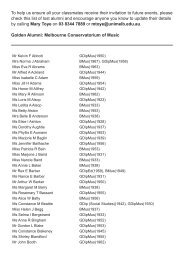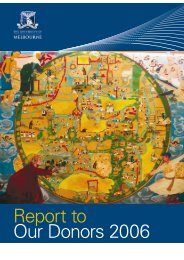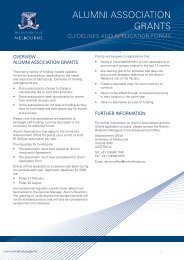Toast to the Town - University of Melbourne
Toast to the Town - University of Melbourne
Toast to the Town - University of Melbourne
You also want an ePaper? Increase the reach of your titles
YUMPU automatically turns print PDFs into web optimized ePapers that Google loves.
THE UNIVERSITY OF MELBOURNE<br />
TOWN AND GOWN 19 th July 2006<br />
GOWN SPEECH<br />
Pr<strong>of</strong>essor Vijoleta Braach-Maksvytis, Deputy Vice Chancellor Innovation and Development<br />
Thank you for your generous <strong>Toast</strong> <strong>to</strong> <strong>the</strong> Gown Michael!<br />
Chancellor, Michael Traill representing <strong>the</strong> <strong>Town</strong>, distinguished guests and my<br />
colleagues <strong>of</strong> <strong>the</strong> <strong>University</strong> community.<br />
<strong>Melbourne</strong> – what a <strong>Town</strong> it is indeed! In <strong>the</strong> 7 months since taking up my new role at<br />
<strong>the</strong> university, <strong>the</strong> most striking impression <strong>of</strong> <strong>Melbourne</strong> has been <strong>the</strong> strong interaction<br />
between <strong>to</strong>wn, gown, culture, government, and <strong>the</strong> community. An extraordinary<br />
achievement, <strong>the</strong> deep passion for <strong>the</strong> arts supported by both government and <strong>Town</strong> and<br />
developed in partnership with <strong>the</strong> Gown, <strong>the</strong> drawing upon <strong>the</strong> Gown for input in<strong>to</strong><br />
government and community issues, and <strong>Town</strong>’s connection with communities through<br />
philanthropic work, backed by government initiatives, and involving <strong>the</strong> Gown and <strong>of</strong>ten<br />
<strong>the</strong> arts. This coherence and interconnection across such different sec<strong>to</strong>rs forms <strong>the</strong> basis<br />
for what is recognized as one <strong>of</strong> <strong>the</strong> most innovative cities in <strong>the</strong> world, as witnessed by<br />
visiting delegations such as <strong>the</strong> delegation from <strong>the</strong> Greater Seattle a couple <strong>of</strong> months<br />
ago, <strong>the</strong> home <strong>of</strong> Micros<strong>of</strong>t, Starbucks, and until recently Boeing, here in <strong>Melbourne</strong>, <strong>to</strong><br />
learn first hand about an innovative city.<br />
1
So how do we nurture this elusive quality called innovation which is so sought after<br />
around <strong>the</strong> globe? Innovation is most commonly associated with technology<br />
breakthroughs or improvements, which are tangible, measurable. Tonight Michael Traill,<br />
however, gave us a quite a different take on innovation. Michael showed what is possible<br />
when knowledge is connected across sec<strong>to</strong>rs which do not usually interact – using<br />
corporate principles <strong>to</strong> enhance <strong>the</strong> endeavours <strong>of</strong> <strong>the</strong> socially disadvantaged, or as he put<br />
it, connecting ‘<strong>the</strong> head and <strong>the</strong> heart’, and <strong>the</strong>n seeing <strong>the</strong> magic happen. At <strong>the</strong><br />
<strong>University</strong> <strong>of</strong> <strong>Melbourne</strong> we have embarked on <strong>the</strong> development <strong>of</strong> knowledge transfer,<br />
<strong>to</strong> connect and embed <strong>the</strong> university more deeply in<strong>to</strong> <strong>the</strong> community.<br />
Human resource direc<strong>to</strong>rs <strong>of</strong> companies rate creativity and innovation as THE most<br />
important graduate skill which will be needed over <strong>the</strong> next ten years. How do you teach<br />
those traits in a lecture <strong>the</strong>atre? Earlier this evening we heard about <strong>the</strong> interaction<br />
between <strong>the</strong> Department <strong>of</strong> Philosophy and Phillips Fox which led <strong>to</strong> new outcomes on<br />
both sides, and <strong>the</strong> creation <strong>of</strong> <strong>the</strong> company Austhink that had its origins in <strong>the</strong> frustration<br />
<strong>of</strong> not being able find real examples in text books with which <strong>to</strong> illustrate <strong>the</strong> <strong>the</strong>ory <strong>of</strong><br />
Philosophy <strong>to</strong> students. The <strong>Melbourne</strong> Theatre Company gave us a taste <strong>of</strong> ‘real time’<br />
innovation, which is bread and butter for <strong>the</strong> performing arts, but <strong>of</strong>ten not recognized as<br />
such.<br />
Tonight’s taste <strong>of</strong> <strong>the</strong> different examples <strong>of</strong> iterative, two-way learning processes, with<br />
outcomes that can move forward issues, create new knowledge, or build solutions, are at<br />
<strong>the</strong> heart <strong>of</strong> what we are defining as The <strong>University</strong> <strong>of</strong> <strong>Melbourne</strong>’s particular knowledge<br />
2
transfer characteristics. T o date we have managed <strong>to</strong> unearth more than 360 examples <strong>of</strong><br />
knowledge transfer from across every faculty in <strong>the</strong> university, showing a myriad <strong>of</strong> ways<br />
which we have worked with over 1300 organisations, and still counting – government,<br />
industry, and community groups, from <strong>the</strong> local <strong>to</strong> global level. The analysis <strong>of</strong> this work,<br />
for <strong>the</strong> first time, will document <strong>the</strong> contributions <strong>to</strong> a broader view <strong>of</strong> innovation –<br />
perhaps it is time for some innovative thinking on innovation itself!<br />
This came <strong>to</strong> mind strongly when I was a panel member some weeks ago for <strong>the</strong> <strong>to</strong>pic<br />
Innovation and Entrepreneurship. Fellow panel members proceeded <strong>to</strong> enthusiastically<br />
define <strong>the</strong> parameters around each <strong>of</strong> <strong>the</strong>se terms, leading <strong>to</strong> some dispute about <strong>the</strong> finer<br />
details and whe<strong>the</strong>r <strong>the</strong>y belonged best <strong>to</strong> <strong>the</strong> meanings for ‘innovation’ or <strong>to</strong><br />
‘entrepreneurship’. The discussion was narrowing down <strong>to</strong> a very linear and constrained<br />
approach <strong>to</strong> <strong>the</strong>se two terms, oddly in contrast <strong>to</strong> <strong>the</strong> original concept <strong>of</strong> innovation and<br />
entrepreneurship! This type <strong>of</strong> discussion was not in fact much different <strong>to</strong> o<strong>the</strong>r<br />
discussions on <strong>the</strong>se issues, and <strong>the</strong> numerous committees which have been set up <strong>to</strong> do<br />
something about <strong>the</strong> lack <strong>of</strong> sufficient innovative or entrepreneurial thinking in Australia,<br />
followed by introducing courses/executive development/new processes and mechanisms,<br />
<strong>to</strong> ensure <strong>the</strong>se attributes can be fostered. And still, a decade later, though we indeed have<br />
moved forward, we still seem <strong>to</strong> be facing <strong>the</strong> same issues and sometimes seem only <strong>the</strong><br />
smallest step closer – so what’s going on, or should I say, what’s not going on?<br />
I recently came across one <strong>of</strong> <strong>the</strong> most striking clues <strong>to</strong> this dilemma when I listened <strong>to</strong><br />
<strong>Melbourne</strong>’s John O’Toole, Pr<strong>of</strong>essor <strong>of</strong> Art Education, when he delivered <strong>the</strong> Faculty <strong>of</strong><br />
3
Education’s Dean’s Lecture. The work originated from some pretty fundamental<br />
knowledge transfer – <strong>the</strong> knowledge came from pre-school children and <strong>the</strong> learnings<br />
have been transferred <strong>to</strong> researchers and teachers. John did a very simple thing, he<br />
juxtaposed <strong>the</strong> learning characteristics <strong>of</strong> children before and after <strong>the</strong>y started school.<br />
Pre-school children learn through all <strong>the</strong> senses, with brain, body and emotions all<br />
working <strong>to</strong>ge<strong>the</strong>r. There is constant exploring and testing, trial and error, and taking risks<br />
- learning by getting it wrong <strong>the</strong> first time, <strong>to</strong> get it right <strong>the</strong> next time, or <strong>to</strong> discover a<br />
completely new path. Pre-school children learn through creative leaps, humour & jokes,<br />
learning is not in isolated bite sized chunks but scaffolded, building on what is already<br />
known; by copying and social interaction, learning from everybody around <strong>the</strong>m, from<br />
peers & playmates, television, <strong>the</strong> people <strong>the</strong>y see and meet. There’s a discovery through<br />
play – musical, linguistic, visual & design, dance, and dramatic play.<br />
Now what happens when a child starts school? They must leave play outside in <strong>the</strong><br />
playground - ‘None <strong>of</strong> that in here please’. Ban <strong>the</strong> emotions, movement and <strong>the</strong> body,<br />
and focus on <strong>the</strong> brain - ‘No tears’, ‘s<strong>to</strong>p laughing’, ‘s<strong>to</strong>p fidgeting’. Language and social<br />
interaction becomes restricted or banned ‘- A quiet classroom is a good classroom’, ‘S<strong>to</strong>p<br />
talking and listen <strong>to</strong> me’. The diverse surroundings are replaced with - ‘The Classroom’,<br />
exploring is replaced with ‘The curriculum’ - ‘We have <strong>to</strong> cover this by Friday’;<br />
playmates, television and <strong>the</strong> people around <strong>the</strong>m are replaced by ‘The Teacher’. Forget<br />
trial and error or risk, as <strong>the</strong>re is only <strong>the</strong> correct answer and penalties for getting it wrong<br />
– ‘I’m disappointed in your marks, Kim’. Gone are <strong>the</strong> creative leaps, imagination and<br />
4
jokes - ‘Don’t be silly’, ‘That’s not funny’. Knowledge is delivered as isolated segments -<br />
‘Today we’ll learn about...’ and above all, <strong>the</strong> arts are marginalised - ‘that’s<br />
messy/noisy/disruptive/outside <strong>the</strong> curriculum’.<br />
Now let’s look at <strong>the</strong> list <strong>of</strong> graduate attributes that employers’ most highly value. A<br />
report that was released last month by <strong>the</strong> UK group DEMOS, 54% <strong>of</strong> HR direc<strong>to</strong>rs say<br />
<strong>the</strong>y find it increasingly difficult <strong>to</strong> find <strong>the</strong> right graduates with <strong>the</strong> right skills, creativity<br />
is regarded as vital for a company’s future. 67% <strong>of</strong> companies now report that <strong>the</strong>y train<br />
managers <strong>to</strong> identify and develop new ideas, and rank ‘having a workforce able <strong>to</strong><br />
identify, develop and adopt new ideas’ as <strong>the</strong> important fac<strong>to</strong>r underpinning innovation.<br />
And what are <strong>the</strong> elements <strong>of</strong> some <strong>of</strong> <strong>the</strong> training given <strong>to</strong> managers <strong>to</strong> foster creativity<br />
and innovative thinking? Brains<strong>to</strong>rming, permission <strong>to</strong> throw ideas around without risk,<br />
<strong>to</strong> scaffold and build on ideas ra<strong>the</strong>r than confine <strong>the</strong>m, explore divergent paths, use<br />
laughter, role-play, movement, team interaction, drawing, gluing, creating pic<strong>to</strong>rial and 3<br />
dimensional structures – sound familiar? How about those characteristics <strong>of</strong> <strong>the</strong><br />
entrepreneur – <strong>the</strong> lack <strong>of</strong> which we constantly lament here in Australia. Entrepreneurs<br />
take risks, in fact a serial entrepreneur is <strong>the</strong> best kind because <strong>the</strong>re’s nothing like a<br />
couple <strong>of</strong> failures under your belt <strong>to</strong> learn what <strong>to</strong> do right.<br />
Back at school, those that have trouble fitting in for whatever reason, can be<br />
marginalised, <strong>the</strong> failures, <strong>the</strong> dummies, destined not <strong>to</strong> succeed. And guess what can<br />
reconnect <strong>the</strong>se marginalised kids – <strong>the</strong> use <strong>of</strong> art, performance, use <strong>of</strong> body and<br />
movement through sport, building with hands, expressing thoughts and sentiments which<br />
5
are valued – utilising some <strong>of</strong> those broader range <strong>of</strong> learning attributes. The <strong>University</strong><br />
has been involved in this type <strong>of</strong> reconnecting work, across a range <strong>of</strong> faculties and with<br />
a range <strong>of</strong> partners. The Project I, is a study <strong>of</strong> homeless young people in <strong>Melbourne</strong> and<br />
Los Angeles, a collaboration between <strong>the</strong> Key Centre for Women’s Health in Society in<br />
collaboration with <strong>the</strong> <strong>University</strong> <strong>of</strong> California, LA. The findings are now being used <strong>to</strong><br />
inform an implementation plan for <strong>the</strong> next decade <strong>of</strong> service delivery <strong>to</strong> young people<br />
who are homeless in Vic<strong>to</strong>ria. Two popular publications were produced for young people<br />
‘Getting Out – true s<strong>to</strong>ries <strong>of</strong> homeless young people’ and ‘674- A pocket guide <strong>to</strong><br />
keeping well on <strong>the</strong> street’, funded by <strong>the</strong> Office <strong>of</strong> Housing and Ian Potter Foundation<br />
respectively. Data on family conflict resulted in <strong>the</strong> development <strong>of</strong> a statewide service<br />
on family mediation, run by <strong>Melbourne</strong> Citymission, <strong>to</strong> name but a few <strong>of</strong> <strong>the</strong> 70 partners<br />
in <strong>the</strong> project.<br />
Innovation clearly leads <strong>to</strong> economic benefit, but <strong>the</strong> route taken can be via social benefit<br />
whose impact can have broad ramifications that we have not begun <strong>to</strong> measure. The<br />
<strong>Town</strong>, and Gown, is already taking this route, and <strong>the</strong>re are indications that a deeper<br />
connection in<strong>to</strong> <strong>the</strong> community is desired, one that creates sustainable longer term<br />
benefits.<br />
Putting <strong>to</strong>ge<strong>the</strong>r different partnerships can create amazing results – magic indeed can and<br />
does happen. The interconnection that is already in <strong>the</strong> fabric <strong>of</strong> <strong>Melbourne</strong> can take a<br />
deeper dimension, through new models <strong>of</strong> partnership, such as one that we are exploring<br />
with Social Ventures - imagine <strong>the</strong> possibilities if we leveraged fur<strong>the</strong>r <strong>the</strong><br />
6
interconnection that <strong>Melbourne</strong> already has. Let’s take that journey <strong>to</strong>ge<strong>the</strong>r and<br />
proactively shape <strong>the</strong> world we live in. I raise a <strong>to</strong>ast <strong>to</strong> <strong>the</strong> <strong>Town</strong>, and indeed what a<br />
<strong>Town</strong> it is!<br />
Can I now ask my <strong>University</strong> colleagues <strong>to</strong> stand and <strong>to</strong> honor <strong>the</strong> <strong>to</strong>ast <strong>to</strong> <strong>the</strong> <strong>Town</strong><br />
“I give you” <strong>the</strong> <strong>Toast</strong> <strong>of</strong> <strong>the</strong> <strong>Town</strong>.<br />
7


